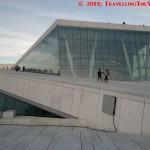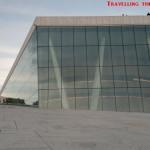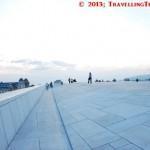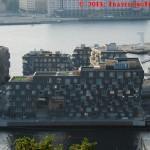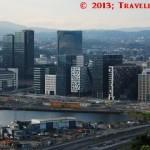In July 2013, I spent just over two weeks on a 13,500 km trip traveling across northern Europe — to Norway, Finland, Estonia and Iceland.
My first visit was to Norway, and it was primarily personal. Two friends of mine live there — one in the capital Oslo and the other in the south-western city of Drammen.
I stayed in Oslo for just under four days, and used the time to engage in some sight-seeing as well.
Facts:
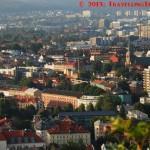
Colours and Nature of Oslo
Oslo city’s population is just over 600,000, but there are almost 1.5 million within the Oslo Metropolitan Region. And it is growing fast. It is one of the fastest growing cities in Europe, and this growth is caused by immigration and intra-country migration.
The city, which is one of oldest in northern Europe, sits at the northern edge of the Oslo fjord, and is surrounded mostly by hills and woods on the other sides.
The city has an excellent public transit system that includes the subway line (T-bane), streetcars, buses, ferries and trains.
Most tourism and travel related websites are in English, and you can get more info from visitnorway.com and visitoslo.com.
The Oslo Opera House
The project was mired in controversy from the very beginning, with many Norwegians questioning the need for such an expensive scheme. But understandably, this was part of a grand plan to revitalize the waterfront, provide Norwegians with a modern cultural center and, on a wider note, to raise Norway’s stature in the cultural world.
It was built ahead of time and well within the budget, and has gone on to win a number of awards, including the International Architecture Award for 2010.
Opera houses serve two purposes — to provide a venue for performances and serve as a tourism ambassador for visitors, particularly for those who are culturally or architecturally inclined.

The Oslo Opera House
But the Oslo Opera House is more than these. The giant white building offers itself for everyone, whether or not they are culturally or architecturally inclined. And this is served by the design, with the white marble roof rising from the ground at the front, and gently rising to the back to match the top of the main building, thus allowing anyone to walk up, and take a look at the city’s landscape. The roof is vast and gentle, allowing whole families to take a stroll. Parts of it is also skateboard-friendly, and I even saw parents pushing their kids on strollers.
There are a number of art works installed as part of the Opera House project and notable among them is the She Lies sculpture, designed by Monica Bonvicini and set to float on a concrete platform on the waters outside the Opera House. It turns on its axis according to the wind and tide.
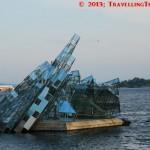
She Lies sculpture
There are more pieces of artwork, including a giant chandelier but time constraints prevented me from going inside. I was content breathing in the panoramic view of the Oslo city from this marble roof.
And while the opera house attracts hundreds of thousands of visitors every year, the area is also developing fast, with new, chic buildings, reminding me of the Austrian artist Friedensreich Hundertwasser‘s buildings.

